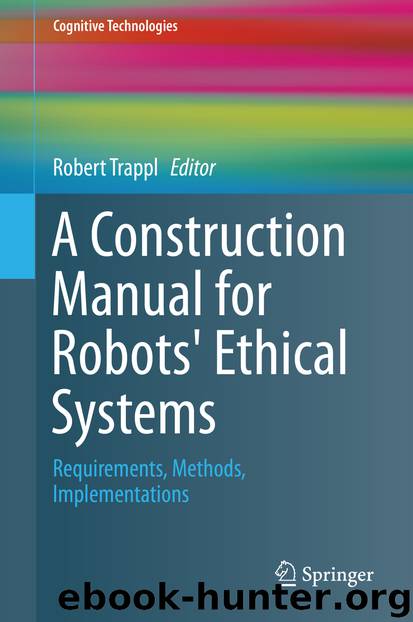A Construction Manual for Robots' Ethical Systems by Robert Trappl

Author:Robert Trappl
Language: eng
Format: epub
Publisher: Springer International Publishing, Cham
6.1.2 Ethical Robotic System
Before going further in depth in our study of the requirements of ethical robotic systems, let us first recall that the word “robot” was first used in 1920 by the Czech author Karel Čapek in a famous theater play entitled R. U. R. (Rossum’s Universal Robots) [4], in which automatons designed to work in place of humans came to substitute humans. The etymology refers to a Slavic root that alludes to work. Indeed, “robota” means drudgery in the Czech language. Furthermore, the Čapek robots are also androids that look like humans. To summarize, the word “robot” simultaneously denotes artificial workers and humanoids. As artificial workers, robots are machines that perform tasks, which are usually accomplished by humans or by animals. As humanoids, they look like humans.
Today, the expression “robotic system” clearly refers to both meanings. On the one hand, some robotic systems, especially those developed for the purposes of computer-human interaction, attempt to imitate humans and to arouse emotions to facilitate dialogues and interactions. On the other hand, many robots, for instance, those used for industrial manufacturing, are designed to autonomously achieve some tasks.
Lastly, there are some robots that are designed for public performances. This is the case with botfights [5] that are intended to fight in arenas like animals and gladiators or with the geminoids of professor Hiroshi Ishiguro [6] who builds androids that are exact copies of himself and his daughter.
Download
This site does not store any files on its server. We only index and link to content provided by other sites. Please contact the content providers to delete copyright contents if any and email us, we'll remove relevant links or contents immediately.
Algorithms of the Intelligent Web by Haralambos Marmanis;Dmitry Babenko(8522)
Test-Driven Development with Java by Alan Mellor(7417)
Data Augmentation with Python by Duc Haba(7309)
Principles of Data Fabric by Sonia Mezzetta(7055)
Learn Blender Simulations the Right Way by Stephen Pearson(6994)
Microservices with Spring Boot 3 and Spring Cloud by Magnus Larsson(6812)
RPA Solution Architect's Handbook by Sachin Sahgal(6225)
Hadoop in Practice by Alex Holmes(6032)
The Infinite Retina by Robert Scoble Irena Cronin(5928)
Jquery UI in Action : Master the concepts Of Jquery UI: A Step By Step Approach by ANMOL GOYAL(5873)
Big Data Analysis with Python by Ivan Marin(5724)
Life 3.0: Being Human in the Age of Artificial Intelligence by Tegmark Max(5403)
Pretrain Vision and Large Language Models in Python by Emily Webber(4686)
Infrastructure as Code for Beginners by Russ McKendrick(4467)
WordPress Plugin Development Cookbook by Yannick Lefebvre(4198)
Functional Programming in JavaScript by Mantyla Dan(4124)
The Age of Surveillance Capitalism by Shoshana Zuboff(4116)
Embracing Microservices Design by Ovais Mehboob Ahmed Khan Nabil Siddiqui and Timothy Oleson(3987)
Applied Machine Learning for Healthcare and Life Sciences Using AWS by Ujjwal Ratan(3965)
